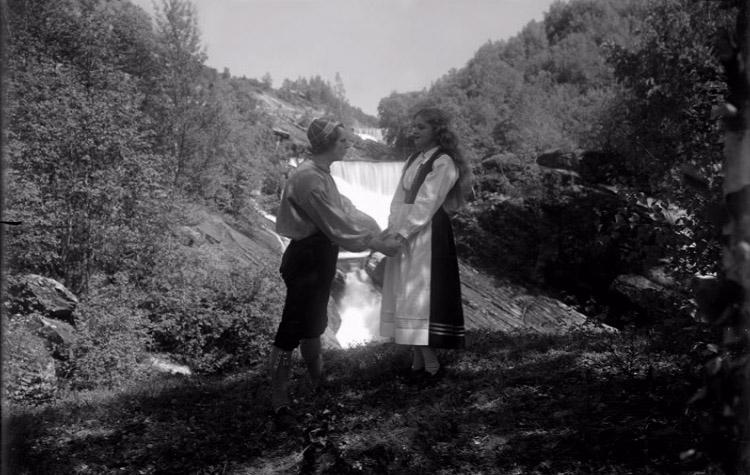
In 1918, a new large, competitive film company was established in Sweden, one which dared to challenge the giant Svenska Bio: Filmindustri AB Skandia. The
company was a fusion between a number of smaller unions: Hasselbladfilm in Gothenburg, Victoria’s Filmbyrå, Svea-Films, Pathé Frères Filial, Biograf AB Sverige and Biograf AB Victoria (this fusion was quite short-lived though: in the end of 1919 a new fusion, now between Svenska Bio and Filmindustri AB Skandia resulted in Svensk Filmindustri (SF)). The new union disposed of enough technical and personal resources to allow for a test of strength. The new company chose to compete in the same field as Svenska Bio, focusing on screen versions of high quality literature. As its literary advisor, Skandia had appointed none other than Gustaf Berg, former head of Statens Biografbyrå (the film censorship board). With his imperturbable defence of cinema’s potential as a quality art form, he stood as a sure guarantor of a solid output.
First came Mästerkatten i stövlar ("Puss in Boots", 1918), a screen version of the novel by Palle Rosenkrantz, directed by John W. Brunius. In its choice of culturally elevated literature, Skandia was hardly inferior to Svenska Bio. It counted a number of trump cards among its films, including Hemsöborna ("People from the Skerries", 1919), based on the novel by August Strindberg and directed by Carl Barcklind, Ett farligt frieri (A dangerous Wooing, 1919) , directed by Rune Carlsten and based on a short story by the Nobel Laureate of 1903, Bjørnstjerne Bjørnson, or the screen version of Thora van Deken, a novel by the recent Nobel Laureate Henrik Pontoppidan.
One other short story by Bjørnson, Synnøve Solbakken from 1857, was adapted for the screen under the auspices of Skandia. The film was directed by John W. Brunius with Hugo Edlund and Arthur Thorell as cameramen. It was produced in the summer of 1919, partly in Skandia’s studio in Långängen, partly in Gudbrandsdalen in Norway, and was released on October 20 the same year in the cinema “Sture” in Stockholm (Åhlander 1986, 410).
Today, when film historical scholarship to an ever-increasing extent has been trying to cover the neglected history of film companies, it would be tempting to try to draw a line between the productions of the newly founded film company and those of the old giant Svenska Bio. Taking A Norway Lass as an example demonstrates how difficult it is to draw such a line, at least in terms of style, as well as between the respective production regimes.
Sam Ask, for instance, who together with Brunius was responsible for the manuscript, had previously collaborated with Victor Sjöström on Dödskyssen (The Death Kiss) and Berg-Ejvind och hans hustru (The Outlaw and his Wife). Since 1912, the photographer Hugo Edlund had also worked as cameraman for Svenska Bio, sometimes together with Julius Jaenzon, and had thus also been responsible for the photography in films directed by Mauritz Stiller as well as Sjöström. As regards the actors in A Norway Lass , the film’s two major attractions were Karin Molander and Lars Hanson. The same tendency is also obvious in other Skandia productions, where Ask and Edlund in particular tend to recur as a team. Also – as has already been noted – the overall ambition of the productions is essentially the same. Thus, it becomes impossible to draw a sharp boundary line between the two companies as regards objectives or casting, as it was previously possible to do between, for example, the films of Hasselblad and those of Svenska Bio.
The plot of the film faithfully follows Bjørnson’s story. On the bright farm Solbakken lives a family belonging to the pietistic Haugean movement, with their daughter, the sweet Synnöve. From the sombre farm Granliden, the boy Thorbjörn casts a longing eye in the direction of Solbakken. Synnöve and Thorbjörn have met in church and have fallen childishly in love. Thorbjörn is influenced by the farmhand Aslak, a devil of a man, who will later be sent away by his father. For many years, the love of the two young people will prevail, but Thorbjörn disgraces himself with Synnöve’s family after a fight with his jealous rival Knud. After another couple of years Synnöve and Thorbjörn meet again and kiss each other, and Thorbjörn promises to restrain his unruly temperament. But Aslak appears again and provokes a new fight between Knud and Thorbjörn, where he also slips a knife into Knud’s hand. Thorbjörn is seriously wounded and during his recuperation he chooses to break up with Synnöve. After having recovered and being reconciled with Knud on the steps of the church, Thorbjörn and his father go together to Solbakken in order to propose to Synnöve. The answer is yes and the two young people are again united in a kiss.

National Aspects
In her thesis Melodrama, kjønn og nasjon (Melodrama, Gender and Nation), Anne Marit Myrstad discusses the relation of Norwegian film to Sweden in its capacity as both an ideal and a source of irritation (Myrstad 1996). The cause of this irritation was of course that Sweden was presumptuous enough to choose Norwegian literary originals in addition to domestic literature for its own national investment in film; even going as far as to launch its cinematic golden age with Ibsen’s well known poem “Terje Vigen”. The critics, however, seem not to have been totally unanimous. Myrstad cites the initials A. H. (probably Alf Harbitz), who in the trade paper Film og Kino 1919 wrote a glowing defence of film’s ability to preserve tradition, where he dwelt on the quality of A Norway Lass, and “was convinced that Swedish film would stimulate love for the nation in Norway” (Myrstad 1996, 89). The large Norwegian audiences for both Terje Vigen (A Man There Was) and A Norway Lass , as commented on by Myrstad, seem to confirm the latter hypothesis of A. H. – in addition to the fact that the films also fostered love for the medium of film itself, which thus also in Norway made its entrance in the cultural sphere with A Man There Was (Myrstad 1996, 89). This, in its turn, caused an additional displeasure, eloquently commented on by Gustav Berg-Jaeger in a review of A Norway Lass in Filmen og vi the following year:
In particular, something as national as the Bjørnsonian peasant tale should have been filmed only by and with Norwegian talent. Berg-Jaeger agreed that A Norway Lass was a great and important film from a film historical perspective, but it was still not authentic. In portraying the environment and the characters, Norwegians would have done a better job. As cinematic preferences vary from country to country the traditions of a particular country could only be rendered truthfully and genuinely by the very people of that nation… (quoted in Myrstad 1996, 90)
The heading of Berg-Jaeger’s review is expressive: “Film we could have made ourselves”. According to Myrstad, this is an opinion for which he was far from the sole advocate.
Even in the Swedish press there were comments on Norwegian versus Swedish when talking of A Norway Lass , e.g. its “magnificent pictures of Norwegian nature” (Stockholms Dagblad, 21 October 1919). More conspicuous is a polemic in the periodical Filmen against the Norwegian system of municipal cinemas, warning against the fatal consequences this might have for the artistic value of the films. Simultaneously the anonymous columnist takes his chance to pat the Norwegians on the head using a very patronizing nationalistic tone:
The result has also been, that as Sweden in a – as we want to say – marvellous mutual competition has created one masterpiece after the other in the area of film, Norway has not been able to come up with more than one solitary film, which in addition was very poor. All around the world our Swedes living abroad may now laugh and weep in front of Swedish films. The Norwegians abroad can never have a glimpse of their country. Well, they will have. Through Sweden. A Norway Lass has been shot. Norwegian mountains and valleys will glide over the screens of the world – but the film company has a Swedish name. A Norwegian national song will now and then be sung, too – but by Swedish films. (Anon. 1920, 10)
Between Text and Picture
Both Leif Furhammar and Rune Waldekranz mention the existing connection between, on the one hand, the tableau-like composition of pictures in A Norway Lass and, on the other hand, Adolf Tidemand’s paintings (Furhammar 1991, 75; Waldekranz 1985, 540, 542). Several reviewers before them had mentioned the same fact, although with varying awareness of the degree of inspiration. Stockholms Tidningen mentions the ”successful study of the famous paintings by Tidemand” (21 October 1919); the critic in Stockholms Dagblad finds ”much of the character of a Tidemand-painting” (21 October 1919); while the critic in Filmen no. 30 (1919), explains that ”some scenes – for example the one that is arranged after the Tidemand-painting with Haugians – come up to the mark above the pass standard”. The connection is a very likely one: Tidemand was Bjørnson’s contemporary and, like him, Norwegian. As an artist, he belonged to the so-called Düsseldorf school, which led the way in genre painting. Neither Furhammar nor Waldekranz, however, analyse this connection more closely. I believe that the connection deserves a more thorough investigation.
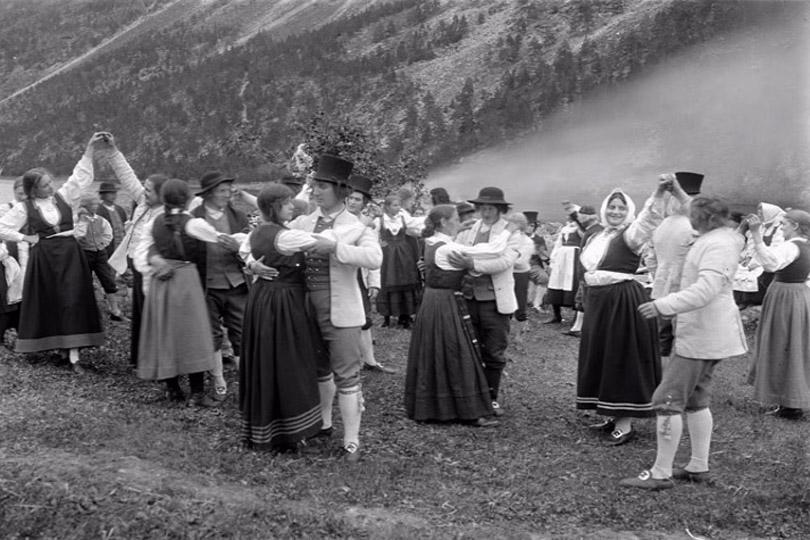
Elsewhere, I have discussed the relation between book illustrations and films in the context of Herr Arnes pengar (Sir Arne’s Treasure, see Florin 1997, 85-107). In this case, however, where a free-standing painting has been inserted into the film, one further element is presented which makes the relation between film images and paintings more complex and thus more interesting to investigate. It is no longer only a matter of representing an illustration that from the very beginning has been subordinated to the contents of the filmed story; rather, it is a question of images independent of both text and film, images that are inserted into a web of interrelations together with them.
Around the mid-point of the film, the farmers celebrate midsummer with a feast and open-air dancing. Then the spectator is transported to Solbakken, where the Haugeans are celebrating the festival in their own way, reading the Bible and praying (the Haugean Christian revivalist movement, which flourished in Norway in the 18th and 19th centuries, defied the ban against lay preaching existing at the time; the movement emphasized strict piety and proscribed drinking, dancing, and other worldly pleasures). We learn that Knut Nordhaug, one of Thorbjörn’s rivals, has joined the Haugeans to impress Synnöve. By means of cross-cutting between the prayer-meeting at Solbakken and the midsummer celebration in the meadow, we then see how Synnöve slips away from the room without anybody noticing and how she gets to the spot where Thorbjörn is. Four times, there is a cut-in of the shot from the room in Solbakken. What is most conspicuous in the whole sequence is the obvious connection to Tidemand’s painting “Haugianerna” (“The Haugeans”) from 1847-48.
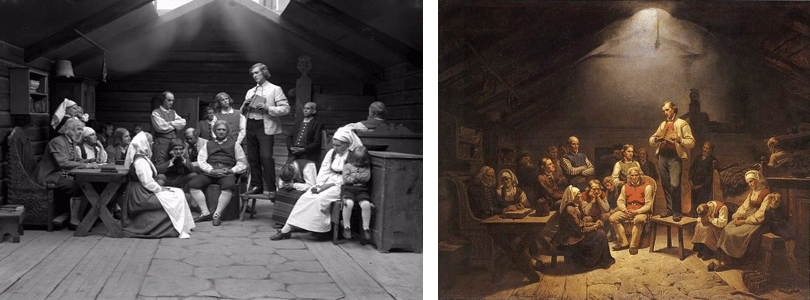
That the Solbakken family are Haugians is evident from a very short sentence in Bjørnson’s first chapter: “The owners of the gard were Haugians, and were called Readers, because they read the Bible more diligently than other people” (Bjørnson 1885, 25). References to Haugianism are made on two other occasions in the book. Firstly, when talking about Synnöve it is said: “[…] she was never found at any dance or other merry-making, because her parents were Haugians” (Bjørnson 1885, 69). Then in a dialogue between Synnöve and a female friend of hers, where the friend diplomatically says that she does not know whether it is a sin to dance, “[…] for she remembered that the Haugians strictly forbade dancing […]”(Bjørnson 1885, 90).
It is interesting to note the similarity between “Haugianerna” and other paintings by Tidemand, e. g. “Fanatikerna” (“The Fanatics,” 1866). This similarity, as well as the fact that he also made other paintings with the same motif but a somewhat different composition, shows that this was a theme that occupied Tidemand over a long period of time. Even if Brunius’ composition of the film image primarily copies “Haugianerna”, there is thus not only that painting but a whole “genre” in Tidemand to fall back on. It is also worth remarking on the central significance this image is accorded in Brunius’ film: owing to the intercutting with the midsummer celebration, he has occasion to return to it several times.
The whole thing becomes even more interesting if one compares Brunius’ film with Bjørnson’s text. The episode with the prayer meeting does not exist in Bjørnson’s story but is an addition by the scriptwriters of the film, Brunius and Sam Ask. The only references to Haugeanism in the book are those I have already mentioned. Thus, it is as if the short story by Bjørnson, on which the film has been based, has been supplemented by the painting by Tidemand and the narrative content that might be extracted from it.
At the same time, the connection to Tidemand is not mentioned anywhere in the film script, which confines itself to a description of the scenes:
292.
TEXT: On Midsummer Eve the farmer abstained from work and celebrated the big festival of the Summer with his wife and children. The young people of the district got together to play and dance.
FADE IN OF AN OPEN AIR DANCE FLOOR situated at the outskirts of the village with a church. Festively dressed young people are dancing to the strains of a couple of fiddlers, while the older people are sitting at long tables at the edge of the plane enjoying food and drink or looking at the dance. The picture fades out.
293.
TEXT: The Haugians celebrated the day in their own way.
FADE IN OF A PREACHER, who is standing on a stool and is reverentially reading the Word. The frame is enlarged to include
294.
THE LARGE LIVING ROOM IN A FARM. Some peasants with wives and children, among them Guttorm and Karen, devoutly listen to the preacher. (Bruinus and Ask [1919])
The fact that the stool is mentioned suggests that the painting by Tidemand seems to have been envisaged even at the script stage, although implicitly. This was probably the starting point for the idea of adding the corresponding scene to the film.
In an analysis of the tradition of the notion of the “folk”, the nation as ethnic group, in the Nordic countries, and particularly in Norwegian painting, Rudolf Zeitler discusses how this notion – emanating from Herder – is presented in Tidemand’s “Haugianerna”:
The scheme of composition in the picture is that of a normal historical painting, but the motif is totally uncommon in European painting in the middle of the 19th century, because here we see common people, each one facing a great spiritual choice. With that Tidemand has abandoned the usual meaning of historical painting, where a hero (possibly also his antagonist) is brought out at the expense of all other – often many – persons in the painting. In Tidemand the central figure – the preacher – has not been portrayed as a hero, he is passive, while all his listeners are spiritually active. (Zeitler 1992, 22)
In the film this emphasis on the collective has clearly been preserved. The anonymity of the preacher is further emphasized by the fact that he is a nameless, otherwise unseen character in the film. But Synnöve and Knud are also placed far back to the left in the image and are very inconspicuous. Only in two insert shots are they brought into focus, and only then do we see in a wide shot– it is the third time that the picture resembling Tidemand is cut in – how Synnöve stands up and leaves the room. Thus, this part of a sequence functions according to two codes, the code of the painting – respecting its agenda – and the code of the film, which emphasizes the singular individual, the heroine.
Then what about the second element in the sequence, i. e. the Midsummer dance? Neither the dancing nor the celebration of Midsummer may be found in Bjørnson. It should be mentioned that the film otherwise faithfully and closely follows the short story upon which it has been based. The only connection to dancing in Bjørnson, indeed, is the two aforementioned references to the fact that the Haugeans did not dance. Thus, the contrast between dancing and pietism is indicated in Bjørnson but is much more distinctly brought out by the contrasting cross-cutting in the film between Midsummer merrymaking and pietistic sternness.
The fact that the film sets the dance specifically at Midsummer could have something to do with another painting, “Midsummer Dance in Rättvik” (1852) by the Swedish painter Kilian Zoll. Such a connection is of particular interest because Zoll was the pupil of Tidemand in Düsseldorf and became his ardent follower.
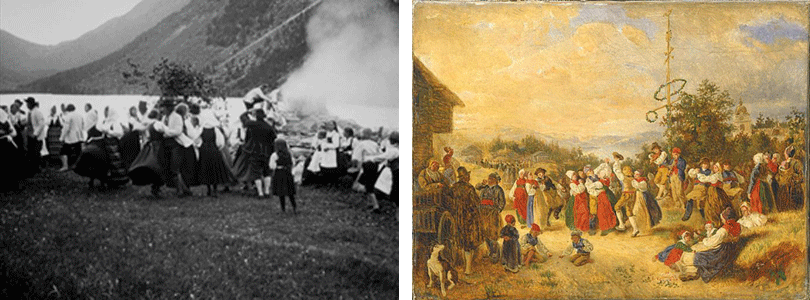
In important respects Zoll’s painting also corresponds to the description of the Midsummer celebration in the script. The young people are dancing whereas the others are looking on. The remark in the script placing the dance floor at the outskirts of the village with a church may bring to mind the church tower visible in the background of the painting. This, however, disappears in the completed film.
Thus Brunius’ addition to Bjørnson’s text seems more than anything else to be based on a visual contrast. This contrast illuminates an opposition which takes its shape from two diametrically different paintings, whose originators are at the same time both active in genre-painting and belong to one and the same school. The ability of the film image to break the static character of painting is dynamically exploited to bring to life the relation between one painting and another.
But back to Tidemand. In Lorentz Dietrichson’s biography of the artist, Adolf Tidemand, hans Liv og hans Vaerker from 1878-79, we find the following quotation from Bjørnstjerne Bjørnson: “Without the help of Adolf Tidemand, I would not have written Synnöve Solbakken” (Dietrichson 1879, 66). It was most likely in his description of pietistic revival in particular that Bjørnson was inspired by Tidemand. I do not know whether there is any evidence that Tidemand himself also read Bjørnson, but Dietrichson imagines him in 1857 with the newly published “Synnöve Solbakken” as travel reading, enchanted to find in literature what he himself had formed in painting. Thus, there is not only a direct connection between Tidemand and Brunius, as I showed earlier, but also – on the face of it – an intertwining of Tidemand and Bjørnson. Thus, what Brunius is doing when he adds the sequence inspired by Tidemand to his film is, if anything, an elucidation of an “intertextual” connection already implicit in the book, rather than an addition per se, as it might at first seem to be.
In his book Texten som tavla (“The text as picture”), from 1982, Hans Lund uses the term “transformation” to represent the kind of pictorial intertextuality which we find when a picture is transformed to text, e. g. when a visual impression or a painting forms the basis of a certain passage of text (Lund 1982, 14ff). A transformation in Lund’s sense occurs in the relation between Tidemand and Bjørnson, or that between Tidemand and the script of Brunius/Ask. When Brunius later transforms this text into a film image again, there is, however, an additional change; one which now takes place in the opposite direction, and this I would like to call an inverted transformation.
So, there is a line from Tidemand to Bjørnson and a line from Bjørnson to Brunius. Moreover, there is a direct line from Tidemand to the script, and from there to the film. Between image and text there is a transformation, and between text and image there is an inverted transformation.
Finally, one further connection between painting and film might be made. In his book of 1987, The Triumph of Light and Nature: Nordic Art 1740-1940, Neil Kent makes an interesting observation:
Most interesting for their reflection of the religious events of this period are two works, Haugianians (1847-48) and Fanatics (1866). In both, the figures are positioned in a theatrical way, gesticulating as though on a stage. This dramatic quality is somewhat reminiscent of dioramas, which had become popular at this time. (Kent 1987, 96)
The highlighting of the diorama in this context creates a connection between the actual painting and the diorama that then leads on to film. The scenic character of the diorama provides the connection, the intermediate link between painting and film image. Thus, the visual correspondence between film image and painting finally points in many different directions, by creating a multidimensional circulation between image and image, between text and image.
Visions and Lies
The visualization in A Norway Lass of inner images is rather unusual: it occurs on six different occasions in the film. At the same time, this dimension in the film is all the more striking because in addition to standard subjective visual images it also includes “false” images. There are two visions, two visualized lies and two visual memories, occurring in this order except for the second lie, which is last in the series. They are consistently inserted into the narrative context by means of first a fade out and then a fade in, both at the beginning and at the end.
Thorbjörn’s visions in his childhood, which both contain one and the same terrible sight of a troll feast in Solbakken, are first conjured up by the farmhand Aslak’s malicious description of the farm, intended to scare the imaginative little boy. Then the vision returns as Thorbjörn at his first meeting with Synnöve outside the church asks the girl if it is true that “your farm is teeming with goblins and trolls and all kinds of evil creatures?”
On both occasions the visualized lies are false flashbacks. Both times, Thorbjörn’s rival Knud is the liar, first in a conversation with Synnöve’s father, Guttorm Solbakken, and a companion of his, then in the presence of Thorbjörn’s father, Saemund Granliden. On neither of these occasions are these flashbacks distinctly marked as subjective; they serve rather to visualize an untrue story and thus they function “collectively” – being images that are conjured up before the eyes of both the narrator and the listeners/spectators. In the first instance, Knud and his friends have provoked Thorbjörn to attack them, an event that has already been shown in detail. Meeting Guttorm Solbakken, Knud now seizes the opportunity to slander his rival, an act which is presented by means of two false flashbacks, interspersed with the image of Knud telling his story. All these transitions to and from the narrator are done by means of fading out and fading in. In Knud’s version, Thorbjörn, totally unprovoked, comes rushing like a savage, a cudgel in his hand, raving against the others. The visual contrast with the course of events that has earlier been shown is striking. The second time is when Saemund calls on Knud to try to find out about the facts relating to the stabbing of Thorbjörn. This has also earlier been shown in images, and Knud’s version of the fight – told in one single flashback – is also this time a quite different one.
The first memory image belonging to Synnöve falls in the scene where Knut Nordhaug has proposed to her. After an establishing image in plan américain, where she is seen standing on the ground outside the house flanked by her parents, there is a cut in to a close-up of her in the middle of the image with her father to the right. An intertitle is inserted with his question: “Have you given your promise to somebody else?” She is looking vacantly in front of herself, and after the usual fade out and fade in, the spectator will see Thorbjörn in medium shot in the same place, a memory of the occasion when he was packed off from Solbakken by Guttorm and gazed wistfully back. In this way, the visual impression is created that he seems to be standing opposite on the slope a bit further away, looking directly at Synnöve.
A new fade out and fade in, however, brings her back into reality, and she answers in the negative to her father’s question. The second memory image fades in just before the scene where Knud is stabbing Thorbjörn, and it is distinctly marked that this image is rendered from the perspective of Thorbjörn. After the fight with Knud, Thorbjörn is shown alone in medium shot. From here there is a transition to the image of Thorbjörn and Synnöve, where part of the intertitle that earlier occurred in this connection is again inserted: “It will be a long time before you will again hear anything bad spoken about me.” It is interesting that both memories bring the daydreamer closer to the picture they remember. On the first occasion, where Synnöve remembers Thorbjörn in a medium shot, he was in the corresponding earlier shot in the film in plan américain. It is the same thing for Thorbjörn, who has been earlier shown in plan américain together with Synnöve, but is now remembering the episode in a close-up. This functions as a strange intensification of the subjective dimension of the film images: they no longer agree with the “objective” picture of the course of events that the spectator has already seen.
The two memory images, one from each protagonist, functionally correspond to the two dreams in the short story, where Synnöve dreams about Thorbjörn and he on his part – even if implicitly – about her. By the reciprocity they reveal, the memory images take over the principal task of these dreams, which is to confirm the constant presence of both parties in the thoughts of the other. But there is an even more concrete foundation for their design in the film. The passage that forms the basis of the second memory image is worked out in Bjørnson in the following way:
Several spoke to him, but he made no reply. He turned away from them, and fell into a reverie; Synnöve was uppermost in it, and he became much ashamed. He wondered what explanation he should give her, and he thought that it was, after all, not so easy for him to stop fighting as he had believed. (Bjørnson 1885, 172)
Here, it is evident that the memory image in the film is firmly founded in the literary original; it renders by cinematic means what Bjørnson has described in words. Similar passages corresponding to all the subjective sections are also to be found in the text, with one single exception: Knud Nordhaug’s first lie.
Looking at the film as a whole, this addition clearly stands out as a link in the series of changes taking place from short story to film, with particular reference to the description of the Knud Nordhaug character. In the short story, he appears for the first time at the wedding when the stabbing will later take place. In the film, however, he is introduced by an intertitle at the confirmation, which immediately precedes the first lie. Next time he returns to Solbakken as a suitor but is refused. He turns up again eavesdropping on a conversation between Synnöve and Thorbjörn, when he also witnesses their kiss. Only then does the fatal incident at the wedding in Nordhaug occur. In this way, Knud has already at an early stage been portrayed as Thorbjörn’s main rival. His character becomes more clear and more absolute than in the short story by being given greater space in the film. This polarization between the hero and his antagonist, where the hero will also finally win the heroine, functions most effectively in the film and entirely according to the demand for clarity in the delineation of character inherent in classical narrative.
Visual Narrative in Bjørnson
In a chapter devoted to “The scene of action as picture and means of expression in eighteenth- and nineteenth-century literature”, literary scholar Erland Lagerroth wrote in 1958 that the description of landscapes in Bjørnsons’s “Fortællinger” only makes use of visual means to a limited extent: "The composition that is most impressive and most thoroughly carried through is probably the founding of the contrast and the conflict between the families in Solbakken and Granliden and the contrast between the position and character of the two farms" (Lagerroth 1958, 173f).
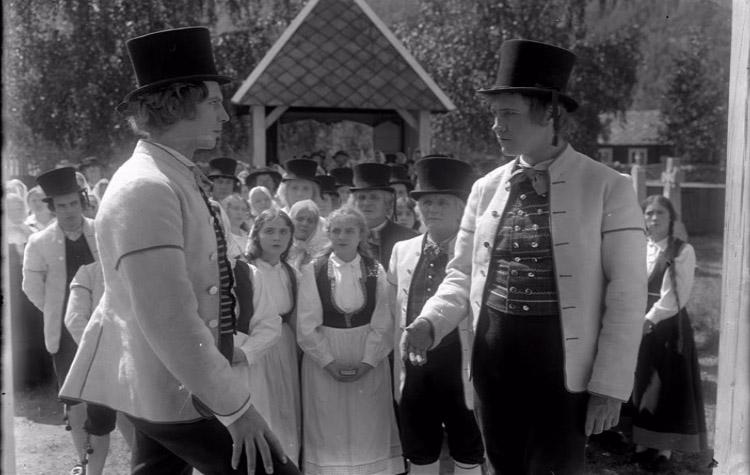
Back in 1919, however, pioneering film reporter Julius Regis reflected upon the general visuality of Bjørnson’s writing in a contribution to a debate in Filmjournalen that is a reply to an intervention by Gustaf Berg. In his capacity as “the literary manager of Skandia”, Berg had stepped forward in defence of the screen version, thus emphasizing that the difference between the original script for the film and the literary original adapted for the screen is minute in regard to the completed result: in both cases a remodelling from word to image must take place. Comparing with France and America, he observes, not without self-righteousness, that “the Swedish superiority lies in discernment as regards adapting for the screen” (Berg 1919, 58). Regis, however, does not agree, and Berg’s activity is only grudgingly approved of:
There are novels, and even more concentrated visually powerful short stories, which are already themselves halfway “moving pictures” and only need a light retouching in order to be transferred to the screen – like “Synnöve”, like “Dunungen”, where the form of the moving picture perfectly fits the content of the literary work. But: could even the most accomplished director succeed in turning any literary work whatever into a moving picture? Hardly so. We willingly look at “Synnöve” on the screen – but not “Hemsöborna”. For Bjørnson’s images, painted in words, are already pictures in themselves, but Strindberg’s dazzling style, converted into images, is Strindberg no more. (Regis 1919, 83)
Bjørnson’s text has strongly cinematic features throughout; its narration is distinct and visual. Concentrated sections of dialogue are woven together with concrete descriptions that sometimes almost take on the character of stage directions. And in the beginning of the decisive scene where Knud and Thorbjörn meet outside the church, even the play of glances between the characters has been described in detail in all its nuances. Even the key scene itself which follows some pages further on is rather graphic:
As one bewildered, he went straight toward them, so that without knowing what he was doing he soon stood face to face with Thorbjörn himself; the latter at once made a movement to turn aside; but several people had come up, and this could not so easily be done. This occurred on the stone slab lying outside of the Fagerlid church. Upon the threshold of the vestibule Synnöve had paused, and Sæmund farther in; as they stood higher than the others, they could distinctly see every one outside, and be seen by them. Synnöve had forgotten all else around her, and only stared at Thorbjörn; the same with Sæmund, his wife, the Solbakke couple, and Ingrid. Thorbjörn felt this, and stood as one nailed to the spot; but Knud thought he must do something here, and so he stretched out one hand a little way, but said nothing. Thorbjörn also put his forward a little, but not so that the two hands could touch. "Thanks for" – began Knud, but remembered at once that this was not the proper greeting here, and drew back a step. Thorbjörn looked up, and his eye fell on Synnöve, who was as white as snow. With a long stride forward and a vigorous grasp of Knud’s hand, he said, so that those nearest could hear it, "Thanks for last [time], Knud; we may have gained much good from it, both of us." (Bjørnson 1885, 172).
In the film, this passage has been worked out in close connection with the text. After an establishing shot of the churchgoers flocking together there is a cut across the 180-degree-line so that the meeting of the two antagonists takes place in the foreground of the picture, seen from the front. This also puts them in an elevated position relative to the spectators: all eyes are really turned towards them. Synnöve, however, is lower in the shot, her face being situated in the centre of the image, right between the two rivals. Also, a detail like Knud’s wavering (“as if he was a bit dizzy”) and his impulse to step back has been inserted. Then a new cut across the 180 degree line follows, to a shot of the two men seen from the opposite perspective, from Synnöve’s position, thus making the play of gazes in the scene even more distinct.
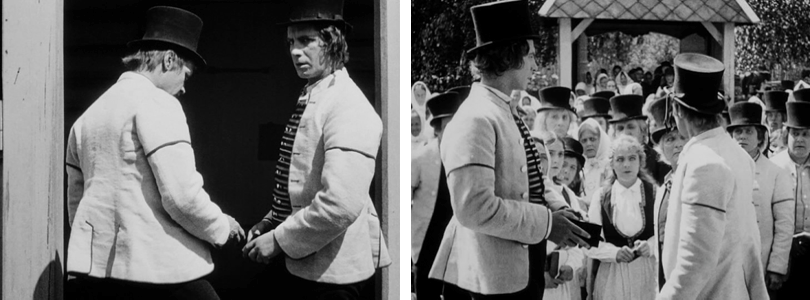
After that, there is a cut back to the earlier image composition, where the handshake now takes place interspersed with a couple of new close cut-ins of Synnöve.
It is interesting to note that the script of the film is a bit more elaborated. A number of enlargements (close-ups) are introduced even before the hand shake (of a couple of farmers, of Guttorm and his wife, of Synnöve and the people from Granliden), something which has in turn been left out of the finished film, in spite of the fact that the two pairs of parents were mentioned in the short story (Brunius and Ask [1919], scene 579-590). The farmers, on the other hand, were probably intended to function as an image of “every one” looking on. One reason for these stylistic choices may be that in the book the scene is composed pretty much like a “general view” where the glance of the reader goes from person to person and between different details, but without really stopping anywhere. Yet the previously mentioned close-ups of Synnöve have after all been inserted, and after the handshake there is also a close-up showing the pain of the parents from Solbakken, a detail which does not feature in the short story. In this way, the film more clearly focusses on the central conflicts of the story: on the one hand, Synnöve’s different relations to the two men, and on the other hand, the opposition of her parents to their daughter’s union with her beloved, which is rescinded in this very scene. A classic filmic cultivation of the most important characters and of the fundamental oppositions in the story has, paradoxically, been realized by means of a reduction of the specifically filmic means of expression.
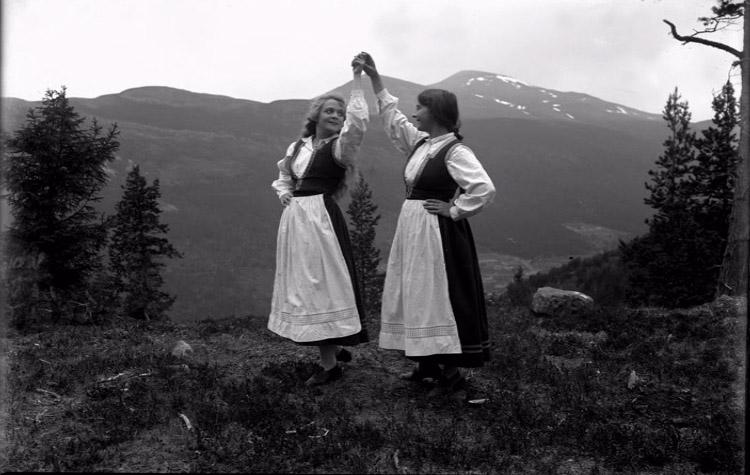
But throughout the entire film, there is also a general principle of composition, which emphasizes a specific kind of image, privileging an overview – either in long shot or in plan américain. The images showing Saemund Granliden carrying his flour sacks, Synnöve and Ingrid Granliden on the summer pasture, the dancers on the wedding farm Nordhaug or the final indoor images from Solbakken on the evening after the church visit, when Saemund and Thorbjörn come courting; all these images function as tableaux vivants. They do so in the same way that the picture of the Haugeans or of the Midsummer dance form the foundation of a whole scene, from which certain cut-ins to details may be made. Thus, these “pictures” play a more important role in the narrative than the classic establishing shot, which only serves as a point of departure for a more systematic cutting into the scene itself. As is evident, these pictures generally have a clear model, either in paintings or in the text of the short story. Brunius’ film creates a constant interplay between these tableaux from painting or literature and a more filmic mode of expression, with cut-ins, iris shots, fade-ins and fade-outs as its basic constituents.
First published in Swedish as "Norska tavlor", in Bo Florin (1997). Den nationella stilen. Studier i den svenska filmens guldålder. Stockholm: Aura förlag.
By: BO FLORIN / ASSOCIATE PROFESSOR / STOCKHOLM UNIVERSITY
Literature
Anon. (1920). "En fosterlandssång i bilder", Filmen 3.
Berg, Gustaf (1919). "Förr, nu och framtid i filmen", Filmjournalen 3.
Bjørnson, Bjørnstjerne (1885). Synnöve Solbakken, Arne, and Early Tales and Sketches, translated by Rasmus B. Anderson, Boston: Houghton, Mifflin and Company.
Brunius, John, and Sam Ask ([1919]). "Synnöve Solbakken," script II, Swedish Film Institute Archive.
Dietrichson, Lorentz (1879). Adolf Tidemand, hans Liv og hans Værker II: Tideman og den nordiske Kunstskole i Düsseldorf (1850-1876), Chistiania: Chr. Tønsbergs Forlag.
Florin, Bo (1997). Den nationella stilen. Studier i den svenska filmens guldålder, Stockholm: Aura förlag.
Furhammar, Leif (1991). Filmen i Sverige, En historia i tio kapitel, Höganäs: Förlags AB Wiken.
Kent, Neil (1987). The Triumph of Light and Nature: Nordic Art 1740-1940, London: Thames and Hudson.
Lagerroth, Erland (1958). Landskap och natur i Gösta Berlingssaga och Nils Holgersson, Stockholm: Bonniers 1958.
Lund, Hans (1982). Texten som tavla. Studier i litterär bildtransformation, Lund: Liber Förlag.
Myrstad, Anne Marit (1996). Melodrama, kjønn og nasjon. En studie av norske bygdefilmer 1920-1930, Dr. art. avhandling, Instututt for drama,film og teater, Norges teknisk-naturvitenskaplige universitet, Trondheim.
Regis, Julius (1919). "Vad säga författarna om filmen?", Filmjournalen 4, 1919.
Waldekranz, Rune (1985). Filmens historia. De första hundra åren från zoopraxiscope till video. Del 1: Pionjäråren, Stockholm: P.A. Norstedt & Söners förlag.
Zeitler, Rudolf (1992). "Johan Gottfried Herders och de tyska romantikernas folktanke och dess inflytande i Norden, särskilt i Norge." In: Jörgen Weibull and Per Jonas Nordhagen (eds.), Natur och nationalitet. Nordisk bildkonst 1800-1850 och dess europeiska bakgrund, Höganäs: Förlags AB Wiken.
Åhlander, Lars, ed. (1986). Svensk Filmografi 1. Uppsala: Almqvist & Wiksell 1986.
Suggested citation
Florin, Bo (2017): Norwegian Tableaux – "Synnöve Solbakken". Kosmorama #269 (www.kosmorama.org).
